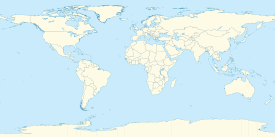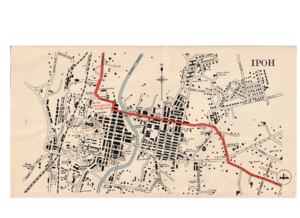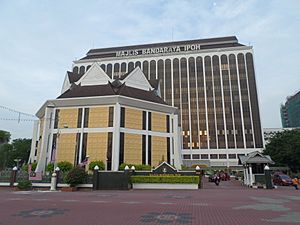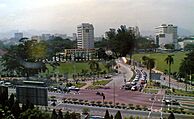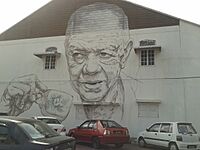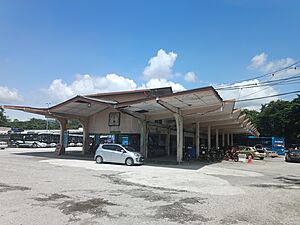Ipoh facts for kids
Quick facts for kids
Ipoh
|
|||
|---|---|---|---|
|
City and state capital
|
|||
| City of Ipoh Bandaraya Ipoh |
|||
| Other transcription(s) | |||
| • Jawi | ايڤوه | ||
| • Mandarin | 怡保 (Simplified) 怡保 (Traditional) Yíbǎo (Hanyu Pinyin) |
||
| • Cantonese | ji4 bou2 (Jyutping) yìh-bóu (Yale Romanisation) |
||
| • Tamil | ஈப்போ Īppō (Transliteration) |
||
|
From top, left to right:
Ipoh city skyline, Old downtown, St. Michael's Institution, Ipoh railway station, City Hall, Kinta Nature Park, Gunung Lang Recreational Park, and Tambun limestone |
|||
|
|||
| Nickname(s):
City of Millionaires, Bougainvillea City, Mountain City, Silver Valley
|
|||
| Motto(s):
Berkhidmat dan Maju
English: Service and Progress |
|||
| Country | |||
| State | |||
| District | Kinta | ||
| Establishment | Around 1880 | ||
| Establishment of the local government | 1893 | ||
| Municipality status | May 31, 1962 | ||
| City status | 27 May 1988 | ||
| Government | |||
| • Type | City council | ||
| • Body | Ipoh City Council | ||
| Area | |||
| • City and state capital | 643 km2 (248 sq mi) | ||
| Elevation | 51.85 m (170.11 ft) | ||
| Population
(2021)
|
|||
| • City and state capital | 840,000 | ||
| • Density | 1,023/km2 (2,650/sq mi) | ||
| • Metro | 1,022,240 | ||
| Demonym(s) | Ipohian / Ipohite | ||
| Time zone | UTC+8 (MST) | ||
| • Summer (DST) | Not observed | ||
| Postcode |
30xxx, 31xxx
|
||
| Area code(s) | 05 | ||
Ipoh is a big city in Malaysia. It is the capital of the Perak state. The city is located by the Kinta River. It is about 200 kilometers (124 miles) north of Kuala Lumpur. It is also about 150 kilometers (93 miles) southeast of George Town in Penang. In 2020, Ipoh had a population of 759,952 people. This makes it the eighth-largest city in Malaysia.
Ipoh is becoming a popular place for tourists. People love its old buildings from the British colonial times. The city is also famous for its delicious food. You can also find amazing natural spots. These include limestone hills and caves. Some of these caves even have Buddhist temples built inside them.
Ipoh is a key travel hub in West Malaysia. This is because it sits between Kuala Lumpur and George Town. The Malayan Railway's West Coast Line and the North-South Expressway both pass through the city. Ipoh also has its own airport, the Sultan Azlan Shah Airport.
Contents
About the Name of Ipoh
The name Ipoh comes from a local tree. This tree is called pohon epu, or more commonly, pokok ipoh. The sap from this plant is poisonous. Local indigenous people used it long ago. They mixed it with other plant sap. Then, they put it on the tips of their blowpipe darts for hunting.
History of Ipoh
Ipoh started as a small village. It grew very quickly in the 1880s. This happened after large amounts of tin were found nearby. The city's location in the rich Kinta River valley, full of tin, helped it grow naturally.
A big fire in Ipoh in 1892 destroyed more than half the town. But this also gave a chance to rebuild the town better. It was rebuilt with a more organized grid pattern. By 1895, Ipoh was the second largest town in the Federated Malay States. These states also included Selangor, Negeri Sembilan, and Pahang.
Ipoh was rebuilt in time for a second tin boom. It grew fast because of the strong tin mining industry. This was especially true in the 1920s and 1930s.
A rich Hakka miner named Yau Tet Shin started building a large part of the town. This was in the early 1930s. This area is now known as the "New Town." It stretches from the eastern bank of the Kinta River to Greentown. In 1937, Ipoh became the capital of Perak. It took over from Taiping.
Japanese forces took over Ipoh on December 15, 1941. In March 1942, the Japanese Civil Administration was set up at St. Michael's Institution. After British forces freed Malaya, Ipoh stayed the capital of Perak. It is still the capital today.
In the 1970s, the tin ran out and tin prices dropped. Because of this, Ipoh faced many years of decline. With the tin mines closing, many people had to find jobs in other Malaysian cities. Even so, Ipoh is still one of Malaysia's largest cities by population. Today, tourism is a main reason for the city's economy to grow.
Ipoh became a Municipality in 1962. In 1988, the Sultan of Perak, Sultan Azlan Shah, declared it a city.
Geography of Ipoh
Land Features of Ipoh
Ipoh is in the state of Perak, in the middle of Peninsular Malaysia. The city is in the karstic Kinta Valley region. It sits on the bank of the Kinta River. Smaller rivers like Sungai Pinji and Sungai Pari also meet here. Hills made of limestone, called mogotes, surround the city. You can find these hills in the northeast, east, and southeast areas.
The Keledang mountain range runs from the north to the west of Ipoh. This range is next to the Bintang mountain range. The Perak River flows on its left side, and the Kinta River on its right. A river called the Pelus River breaks this range north of Ipoh. The Pelus River comes from the Titiwangsa mountain range, which is east of Ipoh.
Climate in Ipoh
Ipoh has a tropical rainforest climate. This means it is hot and wet all year. The city is mostly affected by the Intertropical Convergence Zone. This is a belt of low pressure around the Earth. It rarely has cyclones. So, its climate is known as an equatorial climate.
The temperature in Ipoh does not change much throughout the year. The average temperature is about 28 degrees Celsius (82 degrees Fahrenheit). Ipoh gets a lot of rain all year. On average, it rains 200 mm (7.9 inches) each month. The city gets about 2897 mm (114 inches) of rain per year. October is the wettest month, with about 307.1 mm (12.1 inches) of rain. January is the driest month, with about 256.3 mm (10.1 inches) of rain.
| Climate data for Ipoh (2016–2021) | |||||||||||||
|---|---|---|---|---|---|---|---|---|---|---|---|---|---|
| Month | Jan | Feb | Mar | Apr | May | Jun | Jul | Aug | Sep | Oct | Nov | Dec | Year |
| Mean daily maximum °C (°F) | 32.5 (90.5) |
33.8 (92.8) |
34.2 (93.6) |
33.6 (92.5) |
33.1 (91.6) |
33.1 (91.6) |
33.1 (91.6) |
33.2 (91.8) |
32.7 (90.9) |
32.7 (90.9) |
32.2 (90.0) |
32.2 (90.0) |
33.0 (91.5) |
| Mean daily minimum °C (°F) | 23.5 (74.3) |
23.6 (74.5) |
24.2 (75.6) |
24.6 (76.3) |
24.7 (76.5) |
24.4 (75.9) |
24.3 (75.7) |
24.2 (75.6) |
23.8 (74.8) |
24.1 (75.4) |
24.0 (75.2) |
23.8 (74.8) |
24.1 (75.4) |
| Average precipitation mm (inches) | 132.3 (5.21) |
149.8 (5.90) |
169.9 (6.69) |
259.1 (10.20) |
210.9 (8.30) |
151.8 (5.98) |
156.6 (6.17) |
157.8 (6.21) |
216.0 (8.50) |
297.2 (11.70) |
275.4 (10.84) |
251.1 (9.89) |
2,427.9 (95.59) |
| Average precipitation days (≥ 1.0 mm) | 9 | 10 | 12 | 14 | 14 | 10 | 10 | 12 | 15 | 18 | 18 | 15 | 157 |
| Source 1: Meteomanz | |||||||||||||
| Source 2: World Meteorological Organisation (precipitation) | |||||||||||||
Limestone Caves in Ipoh
The mogotes are the most famous natural features in Ipoh. Many caves are found inside these limestone hills. Some of these caves have temples built inside them. The Sam Poh Tong Temple is a great example. Another is Kek Lok Tong, which means "Cavern of Utmost Happiness." It is on the other side of the same hill. You can reach it through the Gunung Rapat housing area. Other cave temples in Ipoh include Ling Sen Tong, Nan Tian Tong, Kwan Yin Tong, and Perak Tong.
Gua Tempurung is a show cave near Gopeng, south of Ipoh. It is open to visitors and popular with people who explore caves, called spelunkers. It is over 3 kilometers (1.9 miles) long. This makes it one of the longest caves in Peninsular Malaysia. Part of the cave has lights and walkways. There are tours of different lengths and difficulty levels. A river flows about 1.6 kilometers (1 mile) through the hill. There are five large rooms inside. These rooms are full of amazing speleothems, like stalactites and stalagmites.
Economy of Ipoh
In its early days, Ipoh grew because of its mining industry. It was once one of the richest cities in Malaysia and Southeast Asia. This was when tin was its main product. In the 1980s, tin prices crashed. This greatly affected Ipoh's economy. However, the city has grown economically since then.
Ipoh is home to the main offices of several big companies. These include:
- Kuala Lumpur Kepong Berhad: A major palm oil company.
- Batu Kawan Berhad: An investment company that owns most of Kuala Lumpur Kepong Berhad.
- Hovid Berhad: A big Malaysian medicine company.
- Old Town White Coffee (or Old Town Berhad): A food and drink company from Ipoh. It is famous for its white coffee.
Other companies listed on the stock market in Ipoh are Perak Transit Berhad, Tasek Cement Berhad, DKLS Industries Berhad, Wellcall Holding Berhad, Rubberex Berhad, and Perak Corp. Ipoh also has the Malaysian offices for some foreign companies. These include Finisar, Voith, ITL Asia Pacific, and Sagami Manufacturers.
How Ipoh is Governed
The Ipoh City Council manages the city. Datuk Rumaizi Baharin is the current mayor of Ipoh. He was appointed in April 2020.
Ipoh is divided into two areas for Parliament. These are Ipoh Barat (Ipoh West) and Ipoh Timor (Ipoh East). The representative for Ipoh Barat is M. Kulasegaran from the Democratic Action Party (DAP). The representative for Ipoh Timor is Howard Lee Chuan How, also from DAP. As of 2022, there were 233,000 voters in Ipoh. Most voters in Ipoh are Chinese. Malays, Indians, and other groups follow them.
Ethnic breakdown of Ipoh's electorate as of 2022 Chinese (63.55%) Malay (18.49%) Indian (17.04%) Other ethnicities (0.92%)
People of Ipoh
Ipoh is still one of Malaysia's biggest cities. In 2010, the city area of Ipoh had 657,892 people. It was the seventh most populated urban center in Malaysia in 2010.
The table below shows the different ethnic groups in Ipoh from the 2010 census. This information comes from the Department of Statistics Malaysia.
| Ethnic groups in Ipoh, 2010 | ||
|---|---|---|
| Ethnicity | Population | Percentage |
| Chinese | 270,165 | 44.11% |
| Bumiputera | 253,592 | 38.55% |
| Indian | 110,024 | 14.07% |
| Others | 1,559 | 0.2% |
| Non-Malaysian | 19,989 | 3.04% |
City Layout and Sights
For a list of areas in Ipoh, see List of Ipoh areas.
Culture in Ipoh
Food in Ipoh
Ipoh has a very active food scene. There are many hawker centers and restaurants. You can find dishes from Malay, Chinese, and Indian cooking. For more details, see
.
Movies and TV Shows Filmed in Ipoh
Many movies have been filmed in Ipoh. Some of them include:
- 1992: Indochine
- 1999: Anna and the King
- 2003: Kadhal Kisu Kisu
- 2005: Sepet
- 2005: Gubra
- 2006: After This Our Exile
- 2006: Goodbye Boys
- 2006: ... Caution
- 2015: Blackhat
Green Spaces and Parks in Ipoh
Ipoh has several nice parks and green areas:
- D. R. Seenivasagam Park (also known as Coronation Park)
- Sultan Abdul Aziz Recreational Park (also known as Polo Ground)
- Kledang Saiong Forest Eco Park
- Botani Eco Park
Theme Parks in Ipoh
There are a few theme parks in Ipoh. These include the Sunway Lost World of Tambun. There was also the Movies Animated Park Studios (MAPS), which is now closed.
Famous Attractions in Ipoh
Some popular places to visit in Ipoh are:
- Qing Xing Ling Leisure & Cultural Village
- Perak Cave Temple
- Banjaran Hotsprings Retreat
- Tasik Cermin (Mirror Lake)
- Gunung Lang Recreational Park
- Pavilion Petting Zoo & Gunung Lang Climbing Park
- Funtasy House Trick Art
- Fujiwara Tofa Shop
- Kinta Riverfront
- Ipoh Town Hall
- Market Lane
Transport in Ipoh
Roads in Ipoh
The old Federal Route 1 connects Ipoh to other big towns and cities. These include Alor Setar, Taiping, and Penang to the north. It also connects to Tapah, Kuala Lumpur, Seremban, and Johor Bahru in the south. Drivers from the east coast can use Federal Route 4 (from Gerik) or Federal Route 185 (from Cameron Highlands).
The newer North–South Expressway is a faster way to travel. However, some towns like Kampar can only be reached using Route 1.
Train Travel in Ipoh
Ipoh's railway station is run by Keretapi Tanah Melayu (KTM). It is in the Old Town. The railway only connects Ipoh to nearby towns and cities. It does not have travel within the city like in Kuala Lumpur. The station building is very grand. Locals sometimes call it the "Taj Mahal of Ipoh."
The KTM Intercity started a shuttle train service between Kuala Lumpur and Ipoh in 2008. The modern Electric Train System (ETS) shuttle began in 2010. These trains travel at about 145 km/h (90 mph). They connect Ipoh and Seremban. The trip between Ipoh and Kuala Lumpur takes about 120 minutes. There are 10 special shuttle train services between these two cities every day. They start at 5 AM from both stations.
Bus Travel in Ipoh
The main bus station for travel between cities is the Amanjaya Integrated Bus Terminal. It is in Bandar Meru Raya, just north of the city. Medan Kidd is the bus station for travel within Ipoh. It is very close to the Ipoh Railway Station. Currently, PerakTransit runs most of the public buses in the city under the name myBAS Ipoh.
Air Travel in Ipoh
The Sultan Azlan Shah Airport is the only airport in Ipoh. It is located near Gunung Rapat. You can find both local and international flights here. Scoot and AirAsia have daily flights from Ipoh to Singapore Changi Airport. Batik Air Malaysia used to have daily flights to Senai International Airport. This connected Ipoh to Johor Bahru. There are also plans for new flights to Indonesia, Singapore, Thailand, and China. There are even talks about building a new airport soon.
Education in Ipoh
Here is a list of schools in Ipoh, Perak:
- Sekolah Izzuddin Shah
- Sekolah Tuanku Abdul Rahman
- Sekolah Menengah Kebangsaan Bercham
- Sekolah Menengah Kebangsaan Tanjung Rambutan
- Sekolah Menengah Kebangsaan Seri Puteri
- Sekolah Jenis Kebangsaan (T) St. Philomena Convent, Ipoh
- Sekolah Kebangsaan Dato' Panglima Kinta, Ipoh
- Sekolah Jenis Kebangsaan (C) Yuk Choy, Ipoh
- SMJK Yuk Choy, Ipoh
- Tarcisian Convent School, Ipoh (TCS)
- Anderson School, Ipoh
- Anglo-Chinese School, Ipoh
- St. Michael's Institution, Ipoh
- SMK Jalan Tasek, Ipoh
- Methodist Girls Secondary School (MGS), Ipoh
- Perak Girls Secondary School (PGS), Ipoh
- SMK Main Convent, Ipoh
- Wesley Methodist School, Ipoh
- Ipoh International School (Private)
- Fairview International School, Ipoh
- Perak Yuk Choy High School (Private), Ipoh
- Poi Lam High School (Private), Ipoh
- Shen Jai High School (Private), Ipoh
- Sekolah Jenis Kebangsaan (T) Kerajaan, Sungai Pari, Ipoh
- Sekolah Jenis Kebangsaan (T) Gunung Rapat, Ipoh
- Sekolah Jenis Kebangsaan (T) Perak Sangeetha Sabha, Ipoh
- SMK Rapat Setia, Ipoh
- SMK Jalan Pasir Puteh, Ipoh
- Sekolah Jenis Kebangsaan (C) Poi Lam, Ipoh
- SMK Seri Keledang, Ipoh
- SMK Menglembu, Ipoh
- SMJK Poi Lam, Ipoh
- Sekolah Jenis Kebangsaan (C) Sam Tet, Ipoh
- SMJK Sam Tet, Ipoh
- SMK Dato Ahmad Said
- Sekolah Jenis Kebangsaan Ave Maria Convent, Ipoh
- SMJK Ave Maria Convent, Ipoh
- Sekolah Jenis Kebangsaan (C) Gunung Rapat, Ipoh
- Sekolah Jenis Kebangsaan (C) Wan Hwa (1)
- Sekolah Jenis Kebangsaan (C) Wan Hwa (2)
- Sekolah Kebangsaan (ACS), Ipoh
- Sekolah Kebangsaan (P) Methodist, Ipoh
- Sekolah Kebangsaan Haji Mahmud Chemor, Ipoh
- Sekolah Kebangsaan Kuala Pari, Ipoh
- Sekolah Kebangsaan Jalan Pegoh
- Sekolah Kebangsaan Jelapang
- Sekolah Kebangsaan Marian Convent, Ipoh
- Sekolah Kebangsaan Raja Ekram, Ipoh
- SMK Raja Perempuan, Ipoh (RPS) Royal Princess School "Cluster School"
- SRK Raja Perempuan, Ipoh (RPS)
- Sekolah Kebangsaan Seri Ampang, Ipoh
- Sekolah Kebangsaan St. Michael's Institution (1), Ipoh
- Sekolah Kebangsaan St. Michael's Institution (2), Ipoh
- Sekolah Jenis Kebangsaan (C) Chung Shan
Sports in Ipoh
Ipoh has a sports complex called Kompleks Sukan MBI. It is also known as MBI Sports Complex. Inside this complex is the Perak Stadium (Malay: Stadium Perak). This is the home stadium for the Perak Football Association. They play in the Malaysia Super League.
Golf courses in Ipoh include the Royal Perak Golf Club. This is off Jalan Sultan Azlan Shah (Tiger Lane). There is also the Meru Golf Club in Jelapang. Another is the Clearwater Sanctuary Golf Club, on the way to Batu Gajah.
Other sports places include the Kilat Club in Pasir Pinji. There is also Ipoh Field (Padang Ipoh) in the Old Town. The Polo Grounds and the Iskandar Polo Club in Ampang Baru are also available.
The Sultan Azlan Shah Cup is a yearly international men's field hockey tournament. It is held in Ipoh.
Famous People from Ipoh
Film and television
- Angie Cheong, actress
- Mimi Chu, actress and singer
- Iqram Dinzly, actor and model
- Mamat Khalid, film director and screenwriter
- Peter Pek, TV host and businessman
- Afdlin Shauki, screenwriter, director and actor
- Patrick Teoh, actor and radio host
- Michelle Yeoh, actress famous for role in Crouching Tiger, Hidden Dragon
- Natasha Hudson, actress and model
- Mandy Lieu, actress and model
Music
- Michael Wong, singer-songwriter
- Jamal Abdillah, pop singer and actor
- Shila Amzah, singer-songwriter and actress
- Ning Baizura, pop and R&B singer, actress
- Francissca Peter, singer-songwriter
- Sophia Liana
- Sam Chin Neng of pop duo Fuying & Sam
Sports (badminton)
- Koo Kien Keat
- Choong Tan Fook
- Lee Wan Wah
- Cheah Soon Kit
- Wong Pei Tty
- Wong Mew Choo
Sports (football)
- Nazirul Naim
- Chan Kok Heng
- Muhamad Khalid Jamlus
- Azizon Abdul Kadir
Sports (others)
- Tony Underwood (rugby)
- Nur Suryani Mohd Taibi (sports shooting)
- Leong Mun Yee (diving)
- Cheong Jun Hoong (diving)
- Cindy Ong Pik Yin (competitive swimming)
Business
- David Ho Sue San of Hovid Berhad and Carotech Berhad
- Lee Loy Seng, founder of Kuala Lumpur Kepong Berhad
- Dr. Wong Jeh Shyan, CEO of CommerceNet Singapore Limited
- Koon Yew Yin, founder of IJM Corporation Bhd and Gamuda Berhad
- Leong Sin Nam, tin mine owner
- Eu Tong Sen, tin mine owner
- Foo Choo Choon, tin mine owner who has a road in Ipoh named after him
- Chung Thye Phin, tin mine owner who has a road in Ipoh named after him
- Leong Fee, tin mine owner
Politics
- Yeoh Ghim Seng, Speaker of the Parliament of Singapore 1970–1989
- Dr Yeoh Eng Kiong, Hong Kong Secretary for Health, Welfare and Food 2002–2004
- S. J. V. Chelvanayakam, Member of the Ceylonese Parliament 1956–1977
- Ahmad Husni Hanadzlah, Second Minister of Finance of Malaysia 2009–2016
- D. R. Seenivasagam, co-founder of the People's Progressive Party
- Lim Keng Yaik, president of the Malaysian People's Movement Party 1980–2007
- Lee Lam Thye, social activist and former politician
- Chang Lih Kang, Malaysian politician
- Lee Chuan How, Member of the Perak State Executive Council 2018–2020
- Yusof bin Ishak, president of Singapore 1965–1970
Other
- Adeline Ooi, curator and art advisor
- Chan Sek Keong, Chief Justice of Singapore 2006–2012
- Lat, cartoonist
- Huen Su Yin, blogger and cake designer
- Desmond Koh, Youtuber and Chief Technical Officer of Coregas
- Tang Siew Mun, academic
- Tang Tuck Kan, artist
- Wu Lien-teh, physician during the Manchurian Plague
Sister Cities of Ipoh
Ipoh has two sister cities. These are cities that have a special friendly relationship:
See also
 In Spanish: Ipoh para niños
In Spanish: Ipoh para niños















